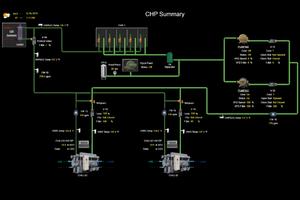Environment
AU Combined Heat and Power System Reuses Waste Heat, Saves Campus Energy and Money

By now, you may have seen or heard about the microturbines installed on top of the Asbury building and the heard about the energy savings they provide to AU. The turbines are part of a larger campus energy conservation plan, called “combined heat and power.”
AU’s new combined heat and power, or “CHP” plant, uses five natural gas-fired microturbines on the rooftop of Asbury building to generate roughly one megawatt of electricity locally on-campus. The combusted natural gas exhaust leaves the turbines at a relatively high temperature of about 535 °F. Rather than sending this hot exhaust gas out to the atmosphere, the plant uses a heat exchanger to extract the thermal energy exhaust gases and put it into the campus heating hot water system (which runs at about 150 °F). This process recovers much of the heat that otherwise would be wasted.
There are multiple environmental and financial benefits to CHP on campus. AU uses this electricity to decrease our dependence on the electrical grid, which reduces strain on the local utility. Energy efficiency is improved in the process by reducing source energy (energy consumption that includes losses from the transportation and production processes) since the energy is converted on campus. Finally, the university can avoid costly extras on power bills such as charges for using energy from the grid during peak demand hours. In a CHP system, there are no peak demand charges, since the energy is generated by the university and can be utilized whenever.
The five microturbines generate enough electricity to power the main campus resident halls. The thermal heat recovery system further optimizes onsite electric generation by heating campus buildings during the winter or to provide cooling in the summer.
During winter operation, the CHP also uses waste heat to produce hot water. This water is then added to the campus heating system. This efficient collection and reuse of waste heat allows for a reduction in the number of boilers used to heat the campus during the winter heating season, saving natural gas as well as producing electricity.
This state-of-the-art system combines the benefits of onsite electrical production with the efficient collection of the waste heat. Coupling that with the efficient campus heating system, everyone at AU can be proud of the positive environmental impact this new system has achieved, not to mention the positive fiscal impact on the utility budget.